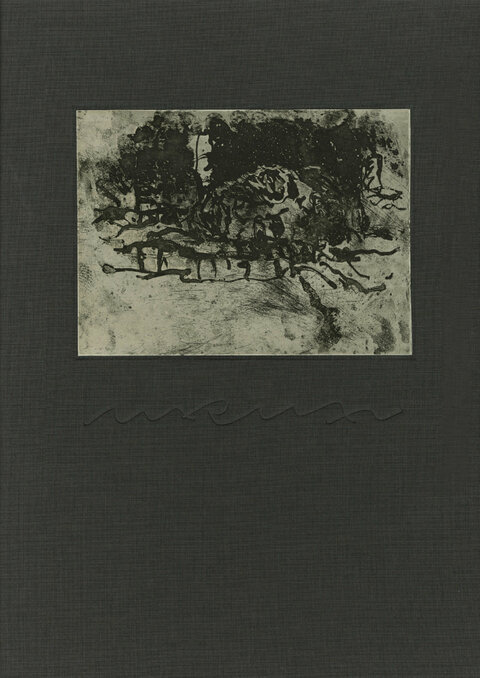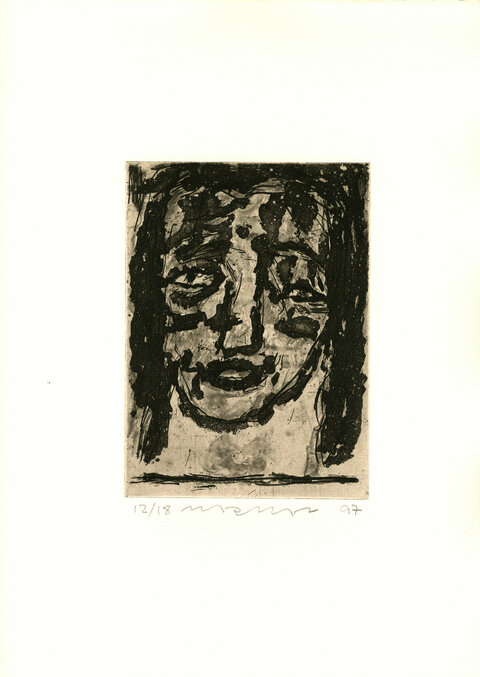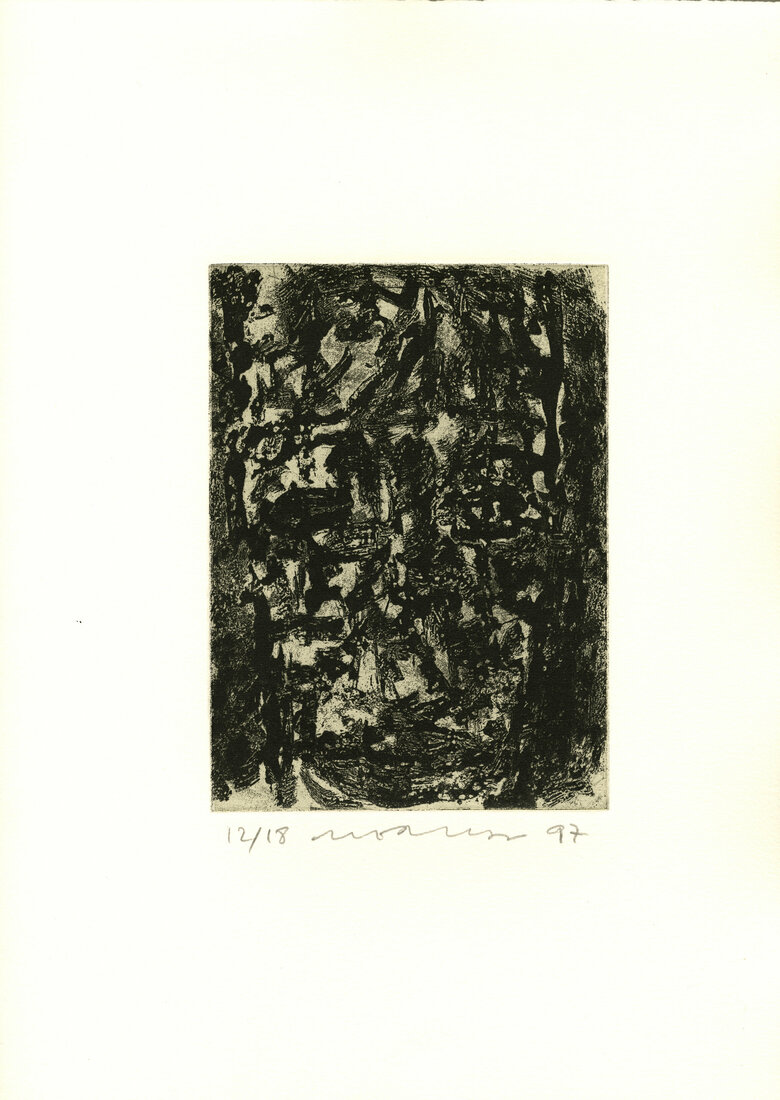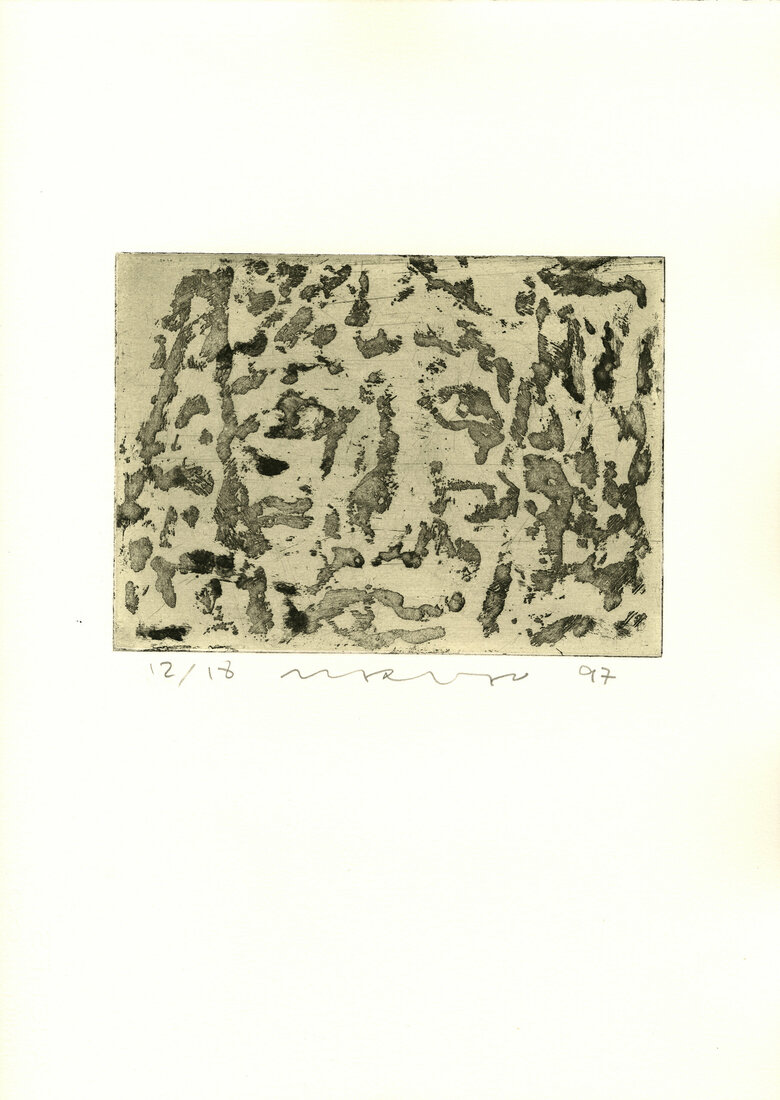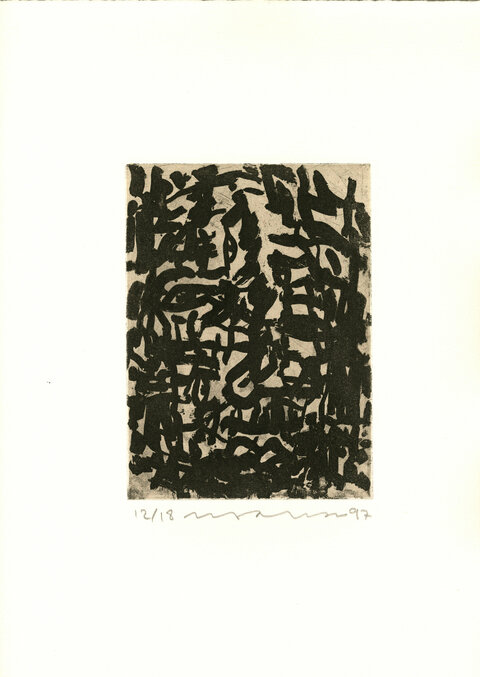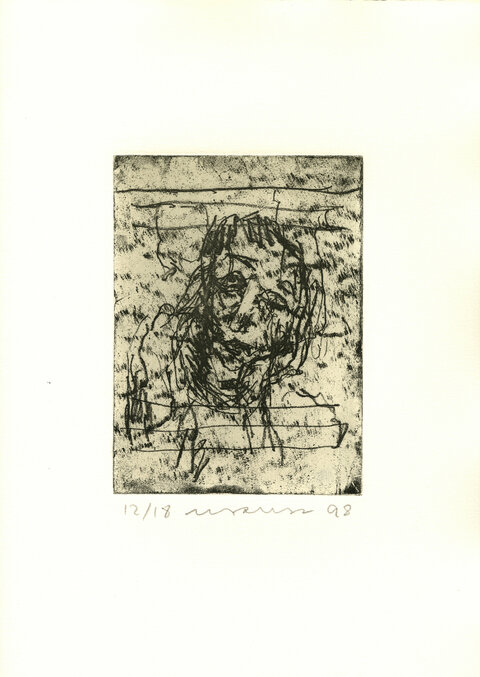Commonly known as ‘Marwan’, Marwan Kassab-Bachi was born in Damascus in 1934 to a wealthy, local family. He studied Arabic literature at the University of Damascus from 1955 to 1957, and...
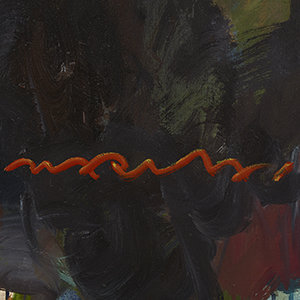

MARWAN KASSAB-BACHI, Syria (1934 - 2016)
Bio
Written by ARTHUR DEBSI
Commonly known as ‘Marwan’, Marwan Kassab-Bachi was born in Damascus in 1934 to a wealthy, local family. He studied Arabic literature at the University of Damascus from 1955 to 1957, and simultaneously trained himself to paint portraits of his surroundings and landscapes. The young student decided to leave for Paris, but because of the difficult political situation in France at that time, he eventually moved to Germany in April 1957. There, he enrolled in the Hochschule der Bildende Künste in Berlin, and completed his training in painting, under the supervision of the German artist Hann Trier (1915-1999). From then on, he spent his life in Germany working as a freelance artist and full-time employee in a fur factory from 1962 to 1970. In parallel to his art practice, Marwan also pursued an active career in the Hochschule der Bildende Künste, and was appointed associate professor in painting between 1977 and 1979, and full professor from 1980 until 2004.
In 1999, the Darat al-Funun Foundation was created in Amman, to provide an art space and residency for artists from the Arab world. Marwan established its Summer Academy. During several summer seasons from its inception to 2003, he supervised workshops that were attended by sixty artists, including several contemporary artists based in Beirut, like the two brothers Saïd (1974-) and Ayman Baalbaki (1975-), Tagreed Darghouth (1979-) and Serwan Baran (1968-). Marwan’s involvement within the Berlin and Arab art scene, as well as higher education, was such that he joined the Akademie der Künste in 1994, becoming the first Arab member of this institution[1].
At the age of 5, Khaddouj, the housekeeper, working for the family, was bathing young Marwan. Accused of looking at her body, she violently slapped him while his face was soap-covered. Since then, she haunted his canvases and he transformed this anecdote and other memories from childhood into visual themes, related to the homeland, sexuality, and sensual feelings.
Marwan’s time in Berlin enabled him to witness several of the country’s important historical events. He saw Germany recover from the destruction of World War II, its division into two blocks in 1961 and then, the fall of the Berlin Wall in 1989. He also lived through the development of Berlin, which turned into a key hub for culture and arts in Europe in the 1960s with the opening of theatres, galleries, and opera houses[2].
Marwan would join the German painters Georg Baselitz (1938-) and Eugen Schönebeck (1936-) in the European artistic movement called ‘New Figuration’ which tended to represent the social and political reality from a more narrative perspective, as opposed to the abstraction of the 1950s[3]. Highly inspired by Expressionism, initiated at the beginning of the 20th century, the artist concentrated on the character of the human being in his entire oeuvre. Qualified as humanistic, his early works almost always depicted one or two figures, such as Untitled (1966) or Im Rotten Kleid (In Red Dress) from 1971 both part of the Dalloul Art Foundation, and somehow he remained attached to figuration by keeping the physical features distinct. Nevertheless, he altered the proportions and put particular emphasis on the energy emanating from the body gestures and facial expressions that he rendered with a vivid line drawing. The standing figures – which are mostly unidentifiable – look tormented, nostalgic, and lonely. They question the human condition. In a certain way, they reveal the psychological impact on a generation of people living during a period of instability and anxiety. Embodying the profile of a humanist, Marwan integrated a significant part of subjectivity in his art as if he displaying his own relationship with the world.
During the 1970s, representing the emotional experience of the individual became an obsession for Marwan. The heads and faces were the ultimate subjects that dominated all of his compositions, using different treatments with a wide range of media, and extending various approaches. From 1970 to 1973, he liked to repeat the motif of the veil seen in the artwork Untitled executed in 1972 (also at DAF). Covering the head, the transparent veil reveals the face, the appearance, and the identity of the person but the painter used the element to metaphorically expose the inner self too. He looked for the truth in what was hidden.
In 1973, Marwan was granted a scholarship to reside in the Cité des Arts in Paris for one year during which he discovered French art History and its multiple avant-garde movements. From this experience, he changed his conception of color[4] that he previously had and which is represented in two examples, both called Facial Landscape respectively dated from 1974 and 1979. Here, he employed warmer colors such as violet, green, or yellow, which reminded him of some memories of Damascus. Yet, he innovated in the technique of application: the paint gives form to the faces and doesn’t fill the spaces between the lines of the drawing. The faces are fragmented because of some blanks that he let appear from the paper. These two pieces belong to the series of works named Gesichtslandschaft or ‘facial landscapes’, from the mid-1970s. From that time, the artist chose to zoom on a specific angle of the face, to capture the human soul and not physical portraits.
Marwan initially modeled the faces after himself and flattened them so they become a sort of landscapes stretching the whole surface of the composition and looking like hills as he did in Untitled (1975). With a quick appliance of earthy tones, he produced enigmatic scenes almost illusionary. Progressively, he presented the heads more abstracted and massive, like Head (1985) applying layers of thicker brush strokes on top of one another with a three-dimensional effect. He exaggerated the proportions of some features by growing the lips, lifting cheekbones, and frowning. The protagonist, whose skin looks mutilated stares at the viewer with deep eyes, thus sharing his sufferings and uncertainties. Marwan believed in the idea of expressing life’s depth through the illustration of faces[5].
Between 1978 and 1983, the painter created another series of portraits of little puppets – he would get back to this theme after twenty-five years. Through these artworks like Marionnette painted in 1983 (also part of DAF’s collection), he blurred the boundaries between abstraction and figuration. Sitting in the middle of the composition, the puppet, ‘al-duma’, is inanimate and seems to be passive. Again, he worked with a palette of warm colors and created a rhythm with interwoven lines that compose the limbs of the toy’s body. He also applied dashes of paint, like stains or dots, which give an impression of a puzzle: a technique similar to the French trend of ‘Tachisme’ from the 1950s consisting in applying spontaneous brushstrokes, drips and blobs of paint straight from the tube. Even if it is intended for children, this object gives rise to numerous interpretations in the collective imagination. It is effectively a pure reproduction of a living being, which is, however, freely manipulated by the user. Marwan highlighted this symbolism and established a correlation with existentialist concepts including the meaning of life, and fate. This is an image that he also allocated to people in the Middle East region, seeing it as a theatrical stage.
Although Marwan spent most of his lifetime in Europe, he had always remained connected to his Syrian origins, as well as the Arab world in general. The notion of identity was a perpetual source of reflection and inspiration for him. He regarded Germany as a country that had recovered from the disasters of war to become a creative and attractive nation; a hope to other countries also going through hard times. He consequently aimed to build bridges between the two cultures and living places he embraced, experimenting with a peculiar style. In the large series of etchings called 99 Heads, from whose 18 editions, one is part of DAF’s collection, he demonstrated his research on the faces while drawing a parallel with the Islamic faith. Companion of Prophet Muhammad (c.570-632), Abu Hurairah (601-676) mentioned in the hadith collection of Sahih al-Bukhari completed in the 9th century: ‘Allah has ninety-nine Names, one-hundred less one (…)’. Here, the artist, a non-dogmatic Muslim, reinterpreted these ninety-nine names into ninety-nine stages of Man’s life.
Marwan Kassab-Bachi passed away in 2016 in Berlin.
[1] Bank, Charlotte, and Ismail Al Rifa'i. Marwan: Topographies of the Soul. Sharjah, UAE: Barjeel Art Foundation, 2014. [Foreword]
[2] Grésillon, Boris. “La Culture Sous Le Sceau De La Guerre Froide. Berlin 1957-1994.” Revue d'Allemagne et des pays de langue allemande. Société d'études allemandes et des pays de langue allemande, June 16, 2018. https://journals.openedition.org/allemagne/517#tocto2n2. [PP-10-11]
[3] Bank, Charlotte, and Ismail Al Rifa'i. Marwan: Topographies of the Soul. Sharjah, UAE: Barjeel Art Foundation, 2014. [P.1]
[4] Maléfan, Pascal Le. “La Marionnette, Objet De Vision, Support De Regard ; Objet Ludique, Support Psychothérapeutique.” Cliniques méditerranéennes. ERES, October 1, 2005. https://www.cairn.info/revue-cliniques-mediterraneennes-2004-2-page-227.htm. [P.3]
[5] “Marwan Kassab-Bachi (1934–2016).” ArtAsiaPacific. Accessed April 27, 2020. http://artasiapacific.com/News/MarwanKassabBachi19342016.
Sources
Bank, Charlotte, and Ismail Al Rifa'i. Marwan: Topographies of the Soul. Sharjah, UAE: Barjeel Art Foundation, 2014.
Boullata, Kamal. "MARWAN". Marwan-art.com. Accessed May 1, 2020.http://www.marwan-art.com/index.php?/project/kamal-boullata-on-marwan/
Eigner, Saeb. Art of the Middle-East, Modern and Contemporary Art of the Arab World and Iran. London, UK: Merell Publishers Limited, 2011.
Grésillon, Boris. “La Culture Sous Le Sceau De La Guerre Froide. Berlin 1957-1994.” Revue d'Allemagne et des pays de langue allemande. Société d'études allemandes et des pays de langue allemande, June 16, 2018. https://journals.openedition.org/allemagne/517#tocto2n2.
Kholeif, Omar. "Omar Kholeif on Marwan Kassab-Bachi (1934–2016)." Artforum.com. Accessed April 28, 2020. https://www.artforum.com/passages/id=65175.
Maléfan, Pascal Le. “La Marionnette, Objet De Vision, Support De Regard ; Objet Ludique, Support Psychothérapeutique.” Cliniques méditerranéennes. ERES, October 1, 2005. https://www.cairn.info/revue-cliniques-mediterraneennes-2004-2-page-227.htm.
“Marwan Kassab-Bachi (1934–2016).” ArtAsiaPacific. Accessed April 27, 2020. http://artasiapacific.com/News/MarwanKassabBachi19342016.
Parry, James V. "Faces in the Landscape." James V Parry. Accessed April 27, 2020. http://www.jamesvparry.com/wp-content/uploads/2011/11/Artist-profile-Marwan1.pdf.
Quilty, Jim. "Marwan and Portraiture as Landscape." Press reader. October 25, 2016. Accessed April 27, 2020. https://www.pressreader.com/lebanon/the-daily-star-lebanon/20161025/282097751245639.
Tyson, Janet, Hakim Bishara, Hrag VartanianVeken Gueyikian, Valentina Di Liscia, Dessane Lopez Cassell, and Dan Schindel. “Saturnine Portraits Somewhere Between Damascus and Berlin.” Hyperallergic, December 7, 2015. https://hyperallergic.com/258568/saturnine-portraits-somewhere-between-damascus-and-berlin/.
CV
Selected Solo Exhibitions
2024
Marwan: Works From 1964 To 2008, Sfeir-Semler Gallery, Hamburg, Hamburg, Germany
2023
Marwan: The Jewels Of My Career, Barjeel Art Foundation, Sharjah, United Arab Emirates
2020
Marwan: Editions, Meem Gallery, Dubai, United Arab Emirates
2018
Works on Paper: 1968-2014, Sfeir-Semler Gallery Hamburg, Germany
2016
Painting, Sfeir-Semler Gallery, Hamburg, Germany
2015
Not Towards Home, But The Horizon, Mosaic Rooms, London, UK
2014
Marwan: Paintings and Drawings (1962-1972), Serralves Foundation, Porto, Portugal
Topography of the Soul, Barjeel Art Foundation at Maraya Art Centre, Sharjah, UAE
2013
Marwan’s Unknown Early Work, Beirut Exhibition Center, Beirut, Lebanon
2012
MARWAN, Galeri Artist, Istanbul, Turkey
2009
Seventy Five, Sfeir-Semler Gallery, Beirut, Lebanon
Painting, Sfeir-Semler Gallery, Hamburg, Germany
Open Until the End - Marwan A Retrospective in Eleven Acts, Haus am Waldsee, Berlin, Germany
2008
The 99 Attributes, The Museum of Islamic Art, Berlin, Germany
2005
Damascus - Berlin - Damascus, Damascus, Syria
Marwan: Khaddousch or the unknown early work. Watercolors and drawings 1962-1971, Lindenau Museum in Altenburg, Altenburg, Germany
2004
Khaled Shoman Foundation, Amman, Jordan
2002
Kunsthalle Emden, Emden, Germany
2001
Khalil Sakakini Cultural Center, Ramallah, West Bank
Richard-Haizmann-Museum, Niebüll, Germany
2000
Brechhaus Weissensee, Berlin, Germany
1998
Abdul Hameed Shoman Foundation, Darat al Funun, Amman, Jordan
1996
Al Hanager Hall, Cairo, Egypt
1995
Abdul Hameed Shoman Foundation, Darat al Funun, Amman, Jordan
1993
Bibliothèque National de Paris, France
Institut du Monde Arabe, Paris, France
1991
Kunststation St. Peter, Cologne, Germany
Haus der Kunst, Munich, Germany
1987
Sfeir-Semler Gallery, Kiel, Germany
1985
Gallery Wolfgang Ketterer, Munich, Germany
1984
Kunsthalle Darmstadt, Germany
1983
Overbeck-Society, Lübeck, Germany
1981
Schloss Bellevue, Documenta-Archiv, Kassel, Germany
1980
Museum of Modern Art, Bagdad, Iraq
1976
Orangerie Schloss Charlottenburg, Berlin, Germany
Gruenenbaum Gallery, New York, US
1972
Gallery Lietzow, Berlin, Germany
1970
Arab Cultural Center, Damascus, Syria
1967
Gallery Springer, Berlin, Germany
Selected Group Exhibitions
2024
There Is No There There, MMK, Museum für Moderne Kunst Frankfurt, Frankfurt, Germany
2023
Modern and Contemporary Art of the Arab World, Christie’s London, London, UK
In the Heart of Another Country: The Diasporic Imagination Rises, Sharjah Art Foundation, Sharjah, United Arab Emirates
Arab Presences: Modern Art And Decolonisation: Paris 1908-1988, Musée d'Art Moderne de Paris, Paris, France
2022
In The Heart Of Another Country, Deichtorhallen Hamburg, Hamburg, Germany
2021
Icons, Boghossian Foundation, Villa Empain, Brussels, Belgium
Memory sews together events that hadn't previously met, Sharjah art museum, Sharjah, UAE
2019
A la Plume, au Pinceau, au Crayon: Dessins du Monde Arabe, Institut du Monde Arabe, Paris, France
Making New Time, Sharjah Biennial 14, Sharjah Art Foundation, UAE
2018
A Century in Flux, Sharjah Art Museum, Sharjah, UAE
2017
Viva Arte Viva, 57th Venice Biennale, Venice, Italy
Beloved Bodies, Barjeel Art Foundation, Sharjah, UAE
Chefs-d’Oeuvre de l’Art Moderne et Contemporain Arabe, Institut du Monde Arabe, Paris, France
Modern Art from the Middle East, Yale University Art Gallery, New Haven, US
Syria: Into The Light, Alserkal Avenue, Dubai, UAE
2016
The Sea Suspended, Tehran Museum of Contemporary Art, Tehran, Iran
The Short Century, Sharjah Museum, Sharjah, UAE
2014
Here and Elsewhere, New Museum, New York, US
2013
Kunst in Berlin. 1945 bis heute, Berlinische Galerie, Berlin, Germany
2011
760 914 cm² Druck, Städtische Galerie Wolfsburg
2010
Peripheral Vision, Barjeel Art Foundation, Sharjah, UAE
2009
Istanbul Biennial, Istanbul, Turkey
Awards and Honors
2005
Merit Order of the Federal Republic of Germany, Germany
Prix Forum Culturel Libanais, Lebanon
2002
Fred-Thiler Prize, Berlin, Germany
1977
Karl Hofer Award, Berlin, Germany
Collections
Guggenheim, Abu Dhabi, UAE
Barjeel Art Foundation, Sharjah, UAE
MATHAF: Arab Museum Of Modern Art, Doha, Qatar
Khalid Shuman Foundation: Darat al Funun, Amman, Jordan
The Ramzi & Saeda Dalloul Art Foundation, Beirut, Lebanon
Solidere, Beirut, Lebanon
National Museum of Damascus, Syria
Atassi Foundation for Arts and Culture, Dubai, UAE
Khalil Sakakini Cultural Center, Ramallah, Occupied Palestine
Birzeit University Museum, Birzeit, Occupied Palestine
State Museums of Prussian Cultural Heritage, Berlin, Germany
Berlinische Galerie, Museum of Modern Art, Photography and Architecture, Berlin, Germany
Foundation Archive of the Academy of Arts, Berlin, Germany
Berliner Bank - BerlinHyp, Berlin, Germany
Art Collections of the Federal Republic of Germany, Bonn, Germany
Graphic CollectionVeste Coburg, Germany
Galerie Neue Meister, Dresden, Germany
Städel Museum, Frankfurt/Main, Germany
Städtisches Museum Göttingen, Germany
Sprengel Museum, Hannover, Germany
Städtisches Museum Jena, Romantikerhaus, Jena, Germany
Hamburger Kunsthalle, Hamburg, Germany
Municipal Museum Jena, Romantikerhaus, Jena, Germany
Museum of Art and Cultural History of the Hanseatic City of Lübeck, Germany
Bavarian State Painting Collection, State Gallery of Modern Art Staatliche Graphische Sammlung, Munich, Germany
Städtische Kunsthalle Mannheim, Germany
Ludwig Galerie Schloss Oberhausen, Germany
Landesmuseum Oldenburg, Germany
Municipal Gallery Wolfsburg, Germany
Tate Modern, London, UK
British Museum, London, UK
Serralves Museum, Portugal
Bibliothèque National de France, Paris, France
Institut du Monde Arabe, Paris, France
Musée–Galerie de la Saita, Paris, France
Centre Georges Pompidou, Paris, France
Carnegie Museum of Art, Pittsburgh, USA
Museum of Contemporary Art Chicago, USA
Press
Connaissancedesarts.pdf
Marwan_s exhibition reminder of Syria_s cultural destruction.pdf
LeFigaro.pdf
الجزيرة.نت.pdf
GulfNews.pdf
Marwan Kassab-Bachi - artforum.com _ critics_ picks.pdf
Al Monitor.pdf
De.Qantara.pdf
Nafas.pdf
المدن - مروان قصاب باشي_ الوجه واحد والمرآة تعدده.pdf
مروان قصاب باشي... ساحر الأيقونات.pdf
مروان قصاب باشي_ صورة الفنان في شبابه.pdf
الحياة - وجه مروان قصاب باشي مرآة ألم الإنسان وهجرته.pdf
مروان قصاب باشي_ الرسم بالرصاص يخرج من كبد الفنان.pdf
Marwan - Khaddousch or The unknown early works.pdf
Marwan Kassab-Bachi’s first GCC exhibition includes three rare paintings - The National.pdf
مروان قصاب باشي _ Darat al Funun.pdf
TheKhalidshomanFoudation.pdf
مروان قصاب باشي بوجوهه الكثيرة.pdf
UstazaParis.pdf
Artforum.pdf
Ft.com.pdf
u-in-u.com.pdf
الفنان مروان قصاب باشي fenon.com فنون.كوم.pdf
CanvasOnline.pdf
Postwar_Hausderkunst.pdf
ArtAsiaPacific- Marwan Kassab Bachi19342016.pdf
BOMB Magazine — Portfolio by Suha Traboulsi.pdf
TheArtNewspaper.pdf
Al-monitor.pdf
Omar Kholeif on Marwan Kassab-Bachi (1934–2016) - artforum.com _ passages.pdf
جريدة الرياض مروان قصاب باشي.. عن رحيل فنان الوجوه المعزولة.pdf
Tagesspiel.pdf
Kamal Boullata on Marwan - marwan-art.com.pdf
ArtSpace.pdf
Marwan Kassab-Bachi, an artist who challenged the landscape of portraiture _ Jimmy Dabbagh _ AW.pdf
AlArab.pdf
الفنان مروان قصاب باشي fenon.com فنون.كوم.pdf
مروان قصاب باشي بوجوهه الكثيرة.pdf
مروان قصّاب باشي_ آخر صورة العالم.pdf
Hyperallergic.pdf
TheKhalidshomanFoudation.pdf
Art Dubai was online only this year, and there were 53,520 visits - The National.pdf
MARWAN KASSAB-BACHI Artwork
Become a Member
Join us in our endless discovery of modern and contemporary Arab art
Become a Member
Get updates from DAF
Follow Artists
Save your favourite Artworks
Share your perspectives on Artworks
Be part of our community
It's Free!
We value your privacy
TermsCookiesPrivacy Policies
Become a Member
Get updates from DAF
Follow Artists
Save your favourite Artworks
Share your perspectives on Artworks
Be part of our community
It's Free!
We value your privacy
TermsCookiesPrivacy Policies
Become a Member
Get updates from DAF
Follow Artists
Save your favourite Artworks
Share your perspectives on Artworks
Be part of our community
It's Free!
We value your privacy
TermsCookiesPrivacy Policies
Welcome to the Dalloul Art Foundation
Thank you for joining our community
If you have entered your email to become a member of the Dalloul Art Foundation, please click the button below to confirm your email and agree to our Terms, Cookie & Privacy policies.
We value your privacy, see how
Become a Member
Get updates from DAF
Follow Artists
Save your favourite Artworks
Share your perspectives on Artworks
Be part of our community
It's Free!
We value your privacy
TermsCookiesPrivacy Policies


